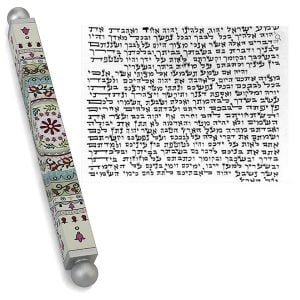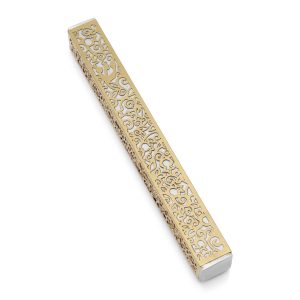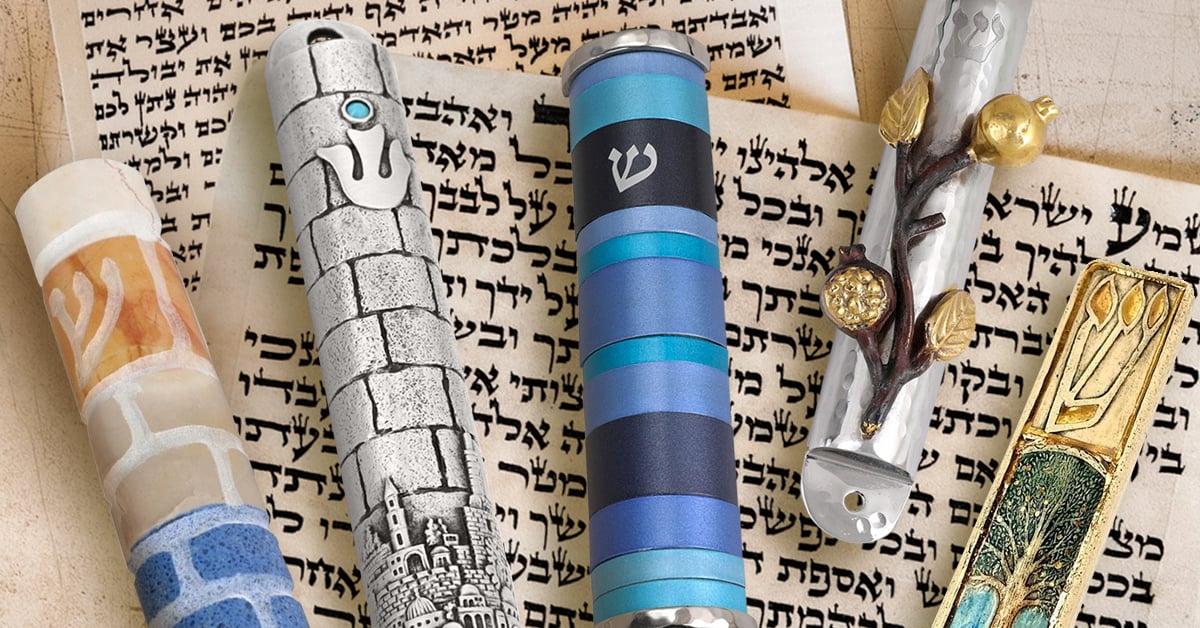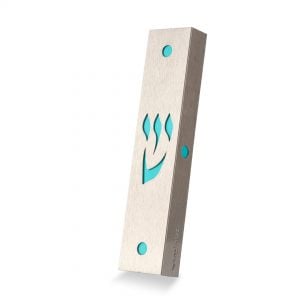You’ve probably seen or heard of mezuzahs on Jewish homes, but where does this tradition come from? What exactly is a mezuzah, and how do you hang one up? We’ve got all your answers here!

A Mezuzah is a beautiful and special Jewish ritual object used to mark the doorposts of Jewish homes. The word “mezuzah” literally means “doorpost,” and it’s a Jewish door ornament and piece of Judaica that fulfills the commandment for Jews to hang the words of the Bible on their doorposts, to literally “write the words of God on the gates and doorposts of your house” (Deuteronomy 6:9).
Originating in the Torah, mezuzahs consist of two parts – the mezuzah case and the mezuzah parchment scroll called a klaf. The klaf contained inside the case is inscribed with specific Hebrew verses: sections of the Shema prayer beginning with the famous words, Shema Yisrael.
Mezuzahs serve two purposes: to remind those entering and leaving of the Divine commandments and the relationship between God and the Jewish people, and to identify one’s dwelling as a Jewish household.

What is a mezuzah made of?

While there are many strict and complex laws surrounding the preparation of the mezuzah scroll, the cases that protect them don’t require any particular specifications.
Mezuzah cases are often decorative and can be made of a variety of different materials ranging from affordable and lightweight plastic cases to ornate masterpieces made from sterling silver, stone, wood, glass, and more.

Mezuzah scrolls, meanwhile, are made from specially-prepared parchment and written by highly trained scribes called sofers, who carefully write each individual sacred letter to perfection. Once the klaf or scroll is complete, it’s rolled up and placed inside the mezuzah case. The case is not sealed permanently, as it is recommended that scrolls be checked for damage or defects at least once or twice every seven years.
What’s the Hebrew letter on many mezuzahs?
Many mezuzah cases are adorned with the Hebrew letter Shin, which stands for “Shaddai,” one of God’s holy names. Shaddai itself is an acronym for Shomer Daltot Yisrael, “Guardian of Israel’s Doors”.
The Shin on a mezuzah therefore refers to God’s protection and guardianship over our homes. Including this motif on the front of a mezuzah case is a common tradition though not a requirement.
How do you put up a mezuzah?

The mezuzah case is affixed to the top third of a doorway on the right, right side up – straight and vertical in Sephardi tradition, and with the top of the mezuzah tilting towards the inside of the room in Ashkenazi tradition. It is customary to keep mezuzahs affixed to every doorway except for bathrooms and small closets.
For ideal mezuzah hanging, one should use mounting tape or nails in order to affix the mezuzah case to the doorpost, with the mezuzah scroll placed inside. (To help you with the proper way to hang a mezuzah on any doorpost, our store sells double-sided adhesive mounting tape here!)
According to Ashkenazi tradition, a mezuzah should be slanted at about a 45-degree angle, pointing towards the inside of the room. In Sephardi tradition, meanwhile, the mezuzah placement is usually straight and completely vertical.
Right before attaching the mezuzah to the door, according to Jewish tradition one also recites the proper blessing or prayer.
Prayer for hanging a mezuzah
The mezuzah blessing recited when hanging a mezuzah, also called the mezuzah bracha, praises God and references the commandment to put up a mezuzah. This mezuzah prayer is said by the person hanging the mezuzah, right before affixing it to the door.
Why is the mezuzah slanted in Ashkenazi tradition?

The mezuzah tilt represents unity and compromise in the Jewish tradition.
The practice of hanging the mezuzah slanted is a compromise between two opinions that existed in medieval Jewish law: one that the mezuzah should be vertical, and one that it should be horizontal. A conclusion was reached that both opinions should be respected by hanging a mezuzah on a slant.

The mezuzah according to Ashkenazi tradition leans to the right towards the inside of the room. It should be at a slight angle, around 45 degrees or less, whatever the width of the doorpost allows, with the top pointing towards the inside of the door and the bottom pointing outwards.
(Sephardi tradition, on the other hand, is to hang the Jewish mezuzah straight and vertical, and both mezuzah placements are commonly seen in Israel today.)
Why do you kiss the mezuzah?
There is a Jewish tradition to kiss a mezuzah when passing one while walking into a home or room. A mezuzah kiss is not a requirement or commandment, but a folk tradition. Most people touch the mezuzah first with their right hand and then kiss the tips of the fingers that touched it.
It comes from the tradition to kiss holy objects, or the fingers or other items that touch them, and a Jewish mezuzah – containing a parchment or mezuzah scroll with holy words of the Torah inside – is one such holy object.
Buy a mezuzah from Israel!

Our store carries a wide range of mezuzahs for sale, including beautiful mezuzah cases from Israeli artists and kosher mezuzah scrolls written by trained religious scribes.
We have a number of beautiful mezuzah cases from well-known Israeli artists, including Dorit Judaica, Ofek Wertman, Yair Emanuel, Danon, Rafael, Shraga Landesman, Adi Sidler, Agayof, and Shoham Yemenite Art.
So hang a mezuzah on your door that showcases the best of Israeli craftsmanship and style, with deep Jewish spiritual meaning!
Find the right mezuzah for your home with our Top 10 list and helpful gift guide, and choose the right scroll to go inside with this handy kosher mezuzah scroll buying guide.











